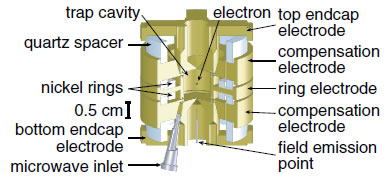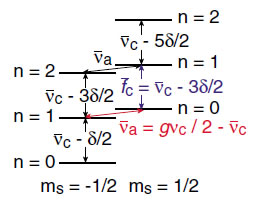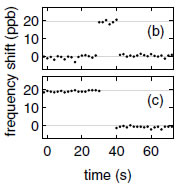The electron magnetic dipole moment is called g/2 when it is measured in Bohr magnetons. It is one of the most accurately measured properties of an elementary particle, and one of the properties of a particle that can be most accurately predicted by the standard model of particle physics. Its measurement is thus an essential part for what is arguably the most stringent test of the standard model and QED. The measured electron magnetic moment and QED theory determine the fundamental fine structure constant much more accurate than does any other method. Comparing the electron and positron magnetic moments is the most stringent test of CPT invariance with a lepton system.
The Gabrielse group reported new measurements of the electron magnetic moment in 2006 and 2008 after 20 years of developing new methods to make this possible. The quoted precision for the latest determination of the electron magnetic moment is 3 parts in 1013. This is about 15 times more accurate than the famous measurement* that had stood since 1987 (see graph) and is shifted by 1.7 standard deviations. A part per trillion is given by ppt = 10-12.


The measurement was carried out with a single electron that was suspended for months at a time in a cylindrical Penning trap (see cut away figure). The magnetic field is from a self-shielding solenoid, an invention we patented that passively cancels the magnetic field fluctuations from external sources. The cylindrical Penning trap was invented long ago for these measurements. The electric field produced by the carefully selected trap geometry is good enough to allow the manipulation and detection of a single electron. The cylindrical microwave cavity that the trap forms around the suspended electron inhibits spontaneous emission by a factor as large as 200 or more, giving the time needed to observe what cyclotron state the electron is in before it decays. The first observation of inhibited spontaneous emission in a cavity and the related theory were some of the earliest papers in what has now come to be known as "Cavity Quantum Electrodynamics."
 |
 |
 and spin flip (below) |
The trap and the electron's cyclotron motion are cooled to about 100 milliKelvin in temperature to make a "quantum cyclotron" - an electron whose cyclotron motion is in its quantum ground state until we deliberately excite it to a higher quantum state. The detection sensitivity we get from our one-electron self-excited oscillator, allows us to resolve the quantum states of the single suspended electron's cyclotron motion (along with its spin state) for the first time using our quantum nondemolition detection method. The electron magnetic moment in Bohr magnetons, g/2, is essentially equal to 1 plus the ratio of the frequencies of the red and blue transitions shown above.
*R.S. Van Dyke, Jr., P.B. Schwinberg, and H.G. Dehmelt, Phys. Rev. Lett. 59, 26 (1987)
Many students from the Gabrielse group contributed over many years, developing the needed new methods one thesis at a time.
| Joshua Dorr | Working to make a better measurement of the electron magnetic moment |
| Shannon Fogwell | Working to compare positron and electron magnetic moments to make the most stringent test of CPT invariance with leptons |
| David Hanneke, Ph.D. | 2008 measurement of the electron magnetic moment |
| Brian Odom, Ph.D. | 2006 measurement of the electron magnetic moment |
| Brian D'Urso, Ph.D. | First one-particle feedback cooling and the first one-particle self-excited oscillator |
| Steve Peil, Ph.D. | First demonstration of a one-electron quantum cyclotron and substantial inhibited spontaneous emission |
| Ching-Hua Tseng, Ph.D. | Relativistic detection methods |
| Daphna Enzer, Ph.D. | Dressed states of the anharmonic oscillator |
| Joseph Tan, Ph.D. | Self-shielding solenoid, first particle in a cylindrical Penning trap, and synchronized electrons too measure cavity radiation modes |
The goal of Shannon Fogwell's thesis work is to compare the positron and the electron magnetic moments. This will be the most stringent test of CPT invariance with leptons. The goal of Joshua Dorr's thesis work is to develop new methods to measure the electron and positron magnetic moments to better than the 3 parts in 1013 that we have already achieved. For these measurements an entirely new apparatus will be used.
© 2015 - Last Updated: 08/30/2018 - Disclaimer